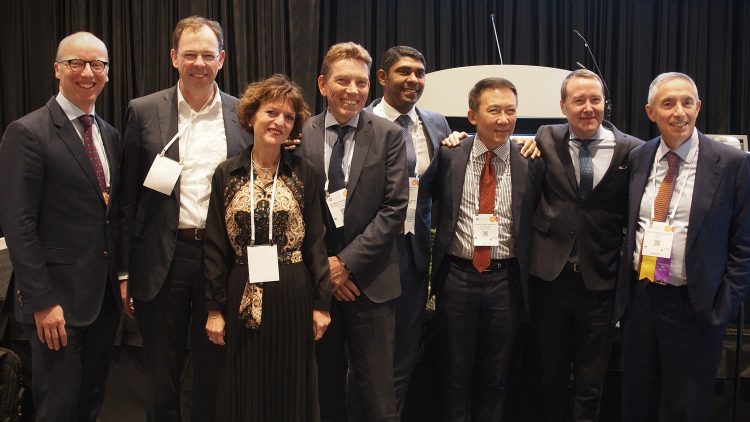Long-term outcomes of refractive surgery

Howard Larkin
Published: Saturday, October 12, 2019
 Pictured at the ESCRS symposium at AAO 2019: (left to right) Oliver Findl, Rudy Nuijts, Béatrice Cochener-Lamard,Thomas Kohnen, Marcony R Santhiago, John Chang, George O Waring IV and Paolo Vinciguerra
At the AAO 2019 Refractive Surgery Subspecialty Day in San Francisco, USA, ESCRS presenters drew on primary research and extensive literature searches to a central question: What Happened To Our Refractive Surgery Patients In The Long Term?
Surface ablation, including PRK and transPRK, lamellar procedures, including LASIK and femtoLASIK, and lenticule extraction procedures, including SMILE, produce comparable visual outcomes with good predictability for periods up to 18 years, said Thomas Kohnen MD, PhD, FEBO, of Goethe University, Frankfurt, Germany. Long-term issues with PRK and LASIK include myopic regression, with LASIK more stable after six years. Challenges include predicting and preventing ectasia and other complications, and accurately calculating IOL power for subsequent cataract surgery.
Rudy MMA Nuijts MD, PhD, of Maastricht University, The Netherlands, focused on angle-supported and implantable collamer lenses. At 10 years, UCDA declined 1.5 Snellen lines due to cataract formation and myopization from increased axial length. Endothelial cell loss varies, with rates two to three times physiological rates. 10-year explant rates may vary up to 12 per cent for iris and 18 per cent for ICLs. Patients should be counselled that pIOLs are a temporary solution.
Long-term toric IOL success depends on rotational stability, said Oliver Findl MD, of Hanusch Hospital, Vienna, Austria. Rotation mostly occurs in the first hours after surgery and is less likely once the capsule fuses, though fibrosis may result in late rotation. When implanting toric IOLs in younger patients, axis shift should be considered, under-correcting patients displaying with-the-rule astigmatism, and fully correcting those with against-the-rule.
Multifocal IOLs are not advisable for patients at risk of central visual field reduction due to macular degeneration, retinal disease or glaucoma, said Beatrice Cochener-Lamard MD, PhD, of the University of Brest, France. Most complications occur in the short term, and at more than 10 years there are no reports of explanation for late complications, including retinal detachment, AMD and PCO. What happens to mIOLs after 20 years is unknown, so care should be taken in implanting them in young patients, said Professor Cochener-Lamard.
Pictured at the ESCRS symposium at AAO 2019: (left to right) Oliver Findl, Rudy Nuijts, Béatrice Cochener-Lamard,Thomas Kohnen, Marcony R Santhiago, John Chang, George O Waring IV and Paolo Vinciguerra
At the AAO 2019 Refractive Surgery Subspecialty Day in San Francisco, USA, ESCRS presenters drew on primary research and extensive literature searches to a central question: What Happened To Our Refractive Surgery Patients In The Long Term?
Surface ablation, including PRK and transPRK, lamellar procedures, including LASIK and femtoLASIK, and lenticule extraction procedures, including SMILE, produce comparable visual outcomes with good predictability for periods up to 18 years, said Thomas Kohnen MD, PhD, FEBO, of Goethe University, Frankfurt, Germany. Long-term issues with PRK and LASIK include myopic regression, with LASIK more stable after six years. Challenges include predicting and preventing ectasia and other complications, and accurately calculating IOL power for subsequent cataract surgery.
Rudy MMA Nuijts MD, PhD, of Maastricht University, The Netherlands, focused on angle-supported and implantable collamer lenses. At 10 years, UCDA declined 1.5 Snellen lines due to cataract formation and myopization from increased axial length. Endothelial cell loss varies, with rates two to three times physiological rates. 10-year explant rates may vary up to 12 per cent for iris and 18 per cent for ICLs. Patients should be counselled that pIOLs are a temporary solution.
Long-term toric IOL success depends on rotational stability, said Oliver Findl MD, of Hanusch Hospital, Vienna, Austria. Rotation mostly occurs in the first hours after surgery and is less likely once the capsule fuses, though fibrosis may result in late rotation. When implanting toric IOLs in younger patients, axis shift should be considered, under-correcting patients displaying with-the-rule astigmatism, and fully correcting those with against-the-rule.
Multifocal IOLs are not advisable for patients at risk of central visual field reduction due to macular degeneration, retinal disease or glaucoma, said Beatrice Cochener-Lamard MD, PhD, of the University of Brest, France. Most complications occur in the short term, and at more than 10 years there are no reports of explanation for late complications, including retinal detachment, AMD and PCO. What happens to mIOLs after 20 years is unknown, so care should be taken in implanting them in young patients, said Professor Cochener-Lamard.